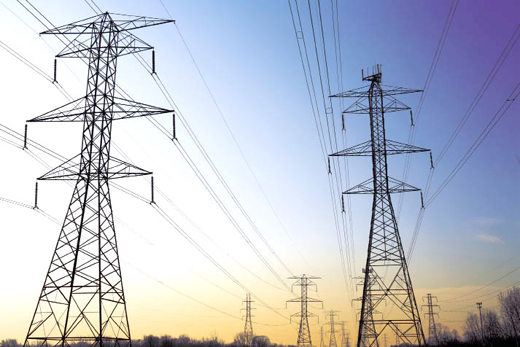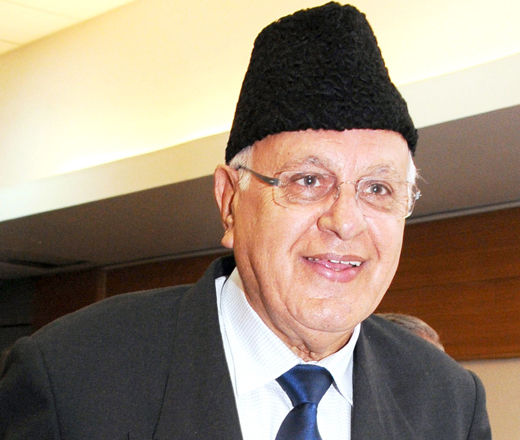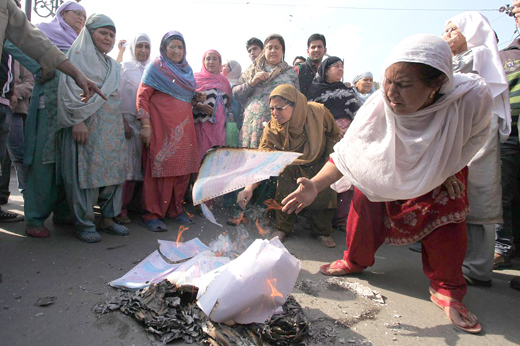Dr Abdullah’s maha-chor comments over the energy pilferages across J&K, triggered a scathing criticism. R S Gull offers an insight into the mess and how systems are seemingly improving with the new investments in the distribution infrastructure
 The unpredictability in Dr Farooq Abdullah’s personality is more frequent in what he says than what he does. That was visible last week when he told a gathering in Delhi that “Kashmiris are not thieves but big thieves” – chor nahi maha chor. People saw the same ease in him while claiming he was misquoted. The fact is he was not misquoted at all.
The unpredictability in Dr Farooq Abdullah’s personality is more frequent in what he says than what he does. That was visible last week when he told a gathering in Delhi that “Kashmiris are not thieves but big thieves” – chor nahi maha chor. People saw the same ease in him while claiming he was misquoted. The fact is he was not misquoted at all.
|
Table 1: Power Tariff Arrears Across Regions |
|||
|
(Rs Cr) |
|||
|
Region |
Arrears |
||
|
Mar-11 |
Mar-12 |
Mar-13 |
|
|
Kashmir |
549.7 |
636.98 |
245.68 |
|
Jammu |
650.89 |
739.5 |
862.03 |
|
Total |
1200.59 |
1376.48 |
1107.71 |
|
Source: Ministry of Power, J&K Government, Jammu |
|||
His comments were condemned and contested within and outside the state assembly and across party and ideological lines. In the debate of hurling insinuations and countering them, people were not informed about the issues that triggered Dr Abdullah to be so uncharitable to the people he is about to beg for vote again. It is all about power pilferages.
Water abundant and energy deficit J&K has been exhibiting a massive mismatch between the expenditure on the energy purchase and the tariff collection (see Table 2: Power Tariff Collections). Nearly half of the investment into the purchase never returns back. It has an off-setting cascading effect on the overall public finances.
But the blame does not go singularly to the consumers. Right now J&K has 1559525 registered consumers but only 801124 have metered connections.
|
Table 2: Power Tariff Collections |
|||
|
(Rs Cr) |
|||
|
Region |
Mar-11 |
Mar-12 |
Mar-13 |
|
Kashmir |
356.79 |
470.5 |
681.46 |
|
Jammu |
587.14 |
721.253 |
1005.25 |
|
943.93 |
1191.753 |
1686.71 |
|
|
Source: Ministry of Power, J&K Government, Jammu |
|||
For many years, J&K has remained somewhere in the top with various north-eastern states as India’s major loss making states in transmission and distribution. At one point of time, the ratio of losses that utilities book between purchase and distribution would mark an indicator of the inefficiency of the distribution system. It is called T&D loss. J&K touched a peak of T&D loss at 63.10 percent in 2008-09 (see Table 4: Technical And Commercial Losses In Energy Sector).
As T&D ratio would not offer the exact health of a transmission and distribution network, the experts came with the concept of AT&C losses. Introduced in last decade, this concept of aggregate technical and commercial losses provides a realistic picture of energy and revenue loss situation because it takes care of both the technical and commercial losses. Year-wise comparison of T&D and AT&C losses (see Table 4: Technical And Commercial Losses In Energy Sector) offers a clear picture of the energy distribution set-up in the state.
|
Table 3: Magnitude Of Transformer Damages Across J&K |
|||
|
Year |
Transformers Aviliable |
Transformers Damaged |
Percentage |
|
2010-11 |
34105 |
14287 |
41.89 |
|
2011-12 |
38875 |
16160 |
41.57 |
|
2012-13 |
42259 |
15745 |
37.26 |
|
2013-14 |
45018 |
9656 |
21.45 |
|
Source: Ministry of Power, J&K Government, Jammu |
|||
But T&D losses does not always mean energy theft though it may have a bit of it included as well. Utilities cannot sell the energy that evaporates in transmission. It is the lack of adequate investment in transmission and distribution networks that push T&D losses up. While high technical losses linked to inadequate investments in the run-down networks, the commercial losses are a result of low metering efficiency, theft and pilferages.
Power transmission and distribution is a complex infrastructure and capital intensive. The state government had a multi-facet approach to tackle the crisis, help improve the run-down distribution network that had remained untouched for decades.
The first help came under Prime Ministers Reconstruction Plan (PMRP). The state government got approval for setting up 28 grid stations across the state – 15 in Jammu and 13 in Kashmir. Right now 22 are commissioned and operational, five are at advanced stage of implementation and one is sub-judice for some reason. This network changed the reliability of a network. It cost darely. Against Rs 789.37 crore, an expenditure of Rs 674.43 crore stands booked already. Besides, a number of sub-220 KV transmission lines were laid in Jammu and Srinagar on which it has booked an overall expenditure of Rs 437.54 crore against an approved outlay of Rs 561.57 crore.

As the state government was creating the grid systems, the centre rolled out accelerated power development reforms programme (APDRP), later re-launched as restructured (R-APDRP). Aimed at reducing AT&C losses, first part of the scheme envisages establishing IT enabled system for achieving reliable and verifiable baseline data system in towns. The scheme is a loan that is converted into a grant once the project completes and is verified by a third party. Second part of the scheme envisages strengthening and upgrading regular sub-transmission and distribution system. For special category states like J&K, 90 percent of the fund requirement is loan that converts into a grant in five tranches depending on extent of maintaining AT&C loss level at 15% level for five years.
It came handy to J&K. As many as 30 towns including 11 in Jammu, two in Ladakh and 17 in Kashmir, will undergo a massive overhaul under this scheme. It makes an overall investment of Rs 1817 crore across the state. The twin capital cities that usually consume most of the energy will take major part of the investment – Rs 655.64 crore for Jammu and Rs 754.67 crore for Srinagar.
Power infrastructure in the periphery is in shambles. Wooden electric poles have decomposed and the conductors are worn out. The distribution lines felling down the poles is nothing uncommon and sometimes it entails human costs.
|
Table 4: Technical And Comercial Losses In Energy Sector |
||
|
Year |
T&D Losses |
AT&C Losses |
|
2002-03 |
47.08 |
65.14 |
|
2003-04 |
48.04 |
69.41 |
|
2004-05 |
47.22 |
66.85 |
|
2005-06 |
47.09 |
66.71 |
|
2006-07 |
51.06 |
67.51 |
|
2007-08 |
61.9 |
72.37 |
|
2008-09 |
63.1 |
70.69 |
|
2009-10 |
63.04 |
72.02 |
|
2010-11 |
62.12 |
74.25 |
|
2011-12 |
61.61 |
72.68 |
|
2012-13 |
57.4 |
64.06 |
|
2013-14 |
52.98 |
59 |
|
Source: Ministry of Power, J&K Government, Jammu |
||
Centre’s Rajiv Gandhi Grameen Vidyutikaran Yojana (RGGVY) launched in March 2005 for electrifying villages came handy. The scheme envisages establishing Rural Electricity Distribution Backbone (REDB) with at least one 33/11KV sub-station in a block, Village Electrification Infrastructure (VEI) with at least a Distribution Transformer in a village and standalone grids with generation where grid supply is not feasible. With Rural Electrification Corporation Limited (REC) as the nodal agency, the scheme is subsidized up to 90 percent.
The scheme is being under implementation in the state. Of the 14 erstwhile districts, NHPC is implementing the project in Kathua, Udhampur, Srinagar, Budgam, Leh, Kargil and Jammu. In the districts of Kupwara, Baramulla, Pulwama, Islamabad, Rajouri, Poonch and Doda, it is implemented through State Power Development Corporation.
NHPC executes the scheme through sub-contracts. Implementation is quite at an advanced stage. Against the cumulative project cost of Rs 632.46 crore assigned to NHPC Rs 507.71 has been spent. J&KSPDC has booked an expenditure of Rs 777.11 crore from an overall kitty of Rs 954.01 crore. So far, 8857 villages are covered and only 1479 villages need to be covered now.
There are two other intervention in the system. Since the overloading of the system has been running havoc with the transformation system, the government permitted the lawmakers to fund the upgradation of the transformers by debit to the constituency development fund (CDF). Lawmakers were authorized to spend one fourth of their CDF on improvement of HT/LT network and augmentation of distribution stations including sub-stations set up under RGGVY. It helped improve situation to a great extent.
|
Table 5: Energy Self Generation And Purchase |
||||
|
Year |
Self Genenation (mu) |
Purchase (mu) |
Total Energy Supplied (mu) |
Costs of purchase (Rs Cr) |
|
2011-12 |
2562.49 |
8528.77 |
11091.26 |
3000 |
|
2012-13 |
2519.94 |
9600.085 |
12120.025 |
3668.4 |
|
2013-14* |
2490 |
10210 |
12700 |
3336.5 |
|
* Estimated |
|
|
|
|
|
Source: Ministry of Power, J&K Government, Jammu |
||||
In 2013-14, the government launched a scheme from its own resources by spending Rs 20 crore (one crore per district) for strengthening the high tension and low tension power distribution lines. By the end of February 2014, half of the amount is released and mostly spent.
All these efforts and so much of investment has started triggering a change. AT&C and T&D losses have fallen by 13.37% and 8.12%, respectively. The distribution losses are targeted to reach a level of 52.98% by the end of March 2014.
|
Table 6: Energy Supply Across J&K Regions |
|||
|
(million units) |
|||
|
Year |
Jammu |
kashmir |
Total |
|
2007-08 |
4012.466 |
4720.552 |
8733.018 |
|
2008-09 |
3948.958 |
5183.15 |
9132.108 |
|
2009-10 |
4653.021 |
5705.004 |
10358.025 |
|
2010-11 |
4763.699 |
5862.917 |
10626.616 |
|
2011-12 |
4922.381 |
6111.492 |
11033.873 |
|
2012-13 |
245.465 |
6835.321 |
12080.785 |
|
2013-14* |
5588 |
7112 |
12700 |
|
* estimated |
|||
|
Source: Ministry of Power, J&K Government, Jammu |
|||
In the last five years, Vikar Rasool, state’s junior power minister told the state assembly, 18000 circuit kilometers of 220-KV and sub-220-KV transmission lines were laid and 2500 MVA transformation capacity added. The improved systems have helped reduce crippling damage to transforming systems. Against damage to 14287 transformers (making 41.89 percent of the overall numbers) in 2010-11 because of overload, the numbers reduced to 9656 (21.45%) in 2013-14 (see Table 3: Magnitude Of Transformer Damages Across J&K).

As the energy requirements are increasing (see Table 6: Energy Supply Across J&K Regions), a lot of purchases are being made (see Table 5: Energy Self Generation And Purchase). J&K consumption has reached nearly 12700 million units in 2013-14. Given the fact that it only manages 2490 million units from all its generation resources, the state is heavily dependent on imports from northern grid. In the current fiscal, it has purchased 10210 million units so far which cost it Rs 3336.50 crore. But the system would require an efficient auditing to prevent theft. Power department must exercise a better control over its field staff that can enhance improved collections.
But that never means there are no thieves and big thieves as Dr Farooq Abdullah talked about. His only problem was that he bracketed entire Kashmir in it. The fact is that there are big chors across regions who are better linked in the system than the common men (see Table 1: Power Tariff Arrears Across Regions, for arrears). The government recently released a list of power tariff defaulters to the state assembly who owed the power department more than ten lakh rupees. They were 149 in Jammu and 42 in Kashmir. It included names of all the politically connected businesses in the state!

